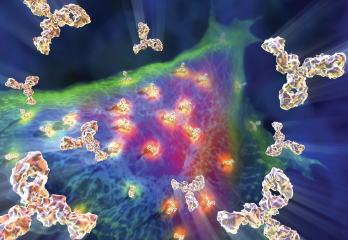
Hybrid Medical Animation / Science Source
A study published in Arthritis & Rheumatology highlights how the presence of autoantibodies to peptidylarginine deiminase (PAD) may eventually be used to influence treatment decisions in the management of rheumatoid arthritis (RA), sharpening our understanding of disease subtypes.1 Although follow-up prospective studies are needed, these findings underline some intriguing areas for future investigations in immunobiology.
PAD Background
The PADs are a family of five related isozymes that catalyze the post-translational citrullination of histones, fibrinogen and other proteins. Erika Darrah, PhD, assistant professor of medicine in the division of rheumatology at Johns Hopkins School of Medicine, Baltimore, is first author of the recent Arthritis & Rheumatology paper, “Association of Baseline Peptidylarginine Deiminase 4 Autoantibodies with Favorable Response to Treatment Escalation in Rheumatoid Arthritis.” She explains that PAD2 and PAD4 are both expressed at relatively high levels in the joints of RA patients, and they seem to be the isozymes most relevant to the disease.
Dr. Darrah notes both are produced by inflammatory cells, particularly white blood cells. She adds, “PAD4 is pretty much restricted to those cell types, but PAD2 is expressed at many sites all over the body.”2
This process of extracellular citrullination sometimes leads to multiple isotypes of autoantibodies to citrullinated antigens, termed anti-citrullinated protein antibodies (ACPAs, which are detected via the cyclic citrullinated peptide [CCP] assay). Although citrullination seems to play an important role in many inflammatory processes, the presence of ACPAs is highly specific for RA. ACPAs also indicate a more severe disease course is likely and more aggressive management may be required.3
Polyclonal antibodies can also develop to the different PAD isoforms themselves, e.g., PAD4 autoantibodies. “PAD4 antibodies are strongly associated with ACPAs and tend to be found in a subset of patients with ACPAs,” Dr. Darrah explains. “If we look just within the CCP-positive individuals, it’s a little less than 50% that will also have antibodies to PAD4.” PAD4 antibodies are found in around 30–35% of the total RA population, making it less sensitive than the standard diagnostic tests for RA: CCP and rheumatoid factor.2
PAD4 antibodies are found at higher rates in patients with more long-standing disease, and they do not appear as often in the preclinical phase of disease compared with a marker such as CCP.2 Several cohort studies have shown PAD4 antibodies are associated with severe erosive disease in patients receiving the standard of care.4-6 However, other evidence suggests that in patients who are also CCP positive, PAD4 autoantibodies are associated with delayed disease onset.7
PAD4 Positivity & Response to Treatment Escalation

Dr. Darrah
Dr. Darrah et al. retrospectively analyzed data from a previous clinical trial, the RA Comparison of Active Therapies in Patients with Active Disease Despite Methotrexate Therapy (RACAT) trial. The 282 participants were failing methotrexate monotherapy and were escalated to receive either 1) methotrexate and etanercept or 2) methotrexate, sulfasalazine and hydroxychloroquine. That study demonstrated both arms were relatively effective in quieting disease activity.8
In the current paper, Dr. Darrah and colleagues analyzed those same patient outcomes with respect to original PAD4-antibody positivity at initiation of treatment escalation using the Disease Activity Score 28 (DAS28) joint assessment and the Sharp/van der Heijde scoring method. Their hypothesis was patients with PAD4 antibodies at baseline would show more progression in their disease with either of these treatments.1
“The results were completely opposite of what we expected, in that the patients actually did better,” says Dr. Darrah. Those patients positive for PAD4 antibodies had longer disease duration and more joint damage seen via radiography, although not in disease activity as measured by the DAS28. But in both unadjusted analyses and multivariable generalized estimating equation models, the patients positive for PAD4 antibodies showed greater improvements in DAS28 and less radiographic progression compared to PAD4-negative patients, regardless of how their treatment changed.
“Even though they came into the study with really severe joint disease, once they were initiated on a more aggressive therapy, they did better than patients who didn’t have the antibody,” says Dr. Darrah. “I think it suggests these patients might potentially benefit from more rapid treatment escalation earlier in the disease course.”1
Dr. Darrah notes that patients with PAD4 antibodies don’t tend to have more elevated markers of inflammation (like C-reactive protein or erythrocyte sedimentation rate) or more swollen and tender joints, although they have more erosive disease seen via X-ray. But these worsening X-ray changes take time to appear. If further work bears out the idea that PAD4-positive patients respond better to more aggressive therapy, the test might help clinicians initiate such therapy earlier, before irreversible joint damage becomes visible via X-ray.
V. Michael Holers, MD, the Scoville Professor of Rheumatology at the University of Colorado School of Medicine, Aurora, notes when the measurement of PAD autoantibodies becomes available as a clinical test, it may be useful in helping make therapeutic decisions. But he cautions, “It’s still a very early period investigation, largely using retrospective cohorts, so you’d have to replicate and validate and confirm clinical utility in other cohorts and in a prospective study design.”
Dr. Darrah also acknowledges that we do not know how the findings might generalize to patients who are methotrexate naive or to other RA subpopulations. She and her colleagues are studying how baseline PAD4 antibody status affects treatment response to drugs with other mechanisms of action.
Dr. Darrah notes the study raises important questions, such as why these patients hadn’t had their treatment escalated earlier. “It’s great that we can reduce their disease activity and slow down their erosive disease,” she says. “We’d like to understand why the PAD4-antibody-positive patients are progressing the way that they are and see if there might be a therapeutic window where we can treat them before they accumulate that severe joint damage—and actually prevent it.”
Other PAD Antibodies
Other research is looking into the potential role of antibodies to other forms of PAD. For example, one study showed antibodies to PAD2 were actually associated with less severe joint and lung disease.9 “There were very few patients who had both PAD2 and PAD4 antibodies,” says Dr. Darrah. “The PAD2-positive patients had fewer swollen joints and were less likely to have lung disease. If we looked at the progression of their disease over time, they had less progression of their erosive joint disease.”
Another interesting area of research is exploring the subset of people who have antibodies that show cross-reactivity to both PAD3 and PAD4 (about half of the people positive for the PAD4 antibody). “This subset seems to identify a group of patients that have the most severe disease with the higher erosive burden,” notes Dr. Darrah. “PAD4 in general is associated with severe joint disease, but that PAD3/PAD4 group was enriched with those with the most severe manifestations.”10,11 These smaller
nested subgroups within CCP-positive patients may give clinicians an even better idea of who might need more aggressive treatments.
Pathophysiology & Future Research Avenues
Much work is still needed to flesh out the pathophysiological processes that might make PAD autoantibodies relevant to RA. Dr. Holers explains that PAD antibodies probably do not play a role in initiating disease development in asymptomatic individuals, as other autoantibodies appear to precede their development. “But they could play a role in the transition to developing arthritis, and they could play roles in modulating the disease process, to increase or decrease it,” he says.
Dr. Darrah suggests studying these antibodies earlier in the disease course may hold the potential for exploring a therapeutic window in which early intervention may prevent joint damage.
As it stands, the issue is quite complex. Antibodies to the different isozymes of PAD might have different effects (e.g., PAD2 vs. PAD4 autoantibodies). Additionally, an individual might have polyclonal antibodies to a specific isozyme of PAD, which may have different physiological impacts. For example, unique anti-PAD4 autoantibodies might react with different sites on the PAD4 enzyme. Depending on the context, distinct PAD4 autoantibodies might either increase or decrease the process of citrullination, known to play an important role in inflammation. Or they might have a variety of other different downstream effects.2,7 As Dr. Holers asks, “What are the effects and functional capacities of individual monoclonal anti-PAD antibodies? I think that’s an important question.”

Dr. Holers
Dr. Holers also sees the question of antibody development as a key question moving forward. “Is there epitope spreading such that there is cross-reactivity between citrullinated target proteins/antigens and then the PADs themselves?” he asks. Through this process, anti-PAD4 antibodies may develop as T and B cells develop immune responses to new epitopes through their association with the initial primary disease epitopes.2
Dr. Holers notes it would also be interesting to explore if people with PAD autoantibodies might more favorably respond to a group of drugs currently under development, PAD inhibitor drugs.
Currently, PAD antibody tests are not available for clinical use, although industry is working on developing tests that might eventually become commercially available. Potentially, these might have value as prognostic assays. “Say you have PAD4 autoantibodies and also PAD3 cross-reactivity; that would help to stratify your risk of severe disease. Throwing in PAD2 antibody testing might give you a different piece of information,” Dr. Darrah speculates.
Although the research is promising, more work needs to be done to demonstrate clinical utility.
Ruth Jessen Hickman, MD, is a graduate of the Indiana University School of Medicine. She is a freelance medical and science writer living in Bloomington, Ind.
References
- Darrah E, Yu F, Cappelli LC, et al. Association of baseline peptidylarginine deiminase 4 autoantibodies with favorable response to treatment escalation in rheumatoid arthritis. Arthritis Rheumatol. 2019 May;71(5):696–702.
- Reyes-Castillo Z, Muñoz-Valle JF, Llamas-Covarrubias MA. Clinical and immunological aspects of anti-peptidylarginine deiminase type 4 (anti-PAD4) autoantibodies in rheumatoid arthritis. Autoimmun Rev. 2018 Feb;17(2):94–102.
- Fox DA. Citrullination: A specific target for the autoimmune response in rheumatoid arthritis. J Immunol. 2015 Jul 1;195(1):5–7.
- Harris ML, Darrah E, Lam GK, et al. Association of autoimmunity to peptidyl arginine deiminase type 4 with genotype and disease severity in rheumatoid arthritis. Arthritis Rheum. 2008 Jul;58(7):1958–1967.
- Halvorsen EH, Pollmann S, Gilboe IM, et al. Serum IgG antibodies to peptidylarginine deiminase 4 in rheumatoid arthritis and associations with disease severity. Ann Rheum Dis. 2008 Mar;67(3):414–417.
- Zhao J, Zhao Y, He J, et al. Prevalence and significance of anti–peptidylarginine deiminase 4 antibodies in rheumatoid arthritis. J Rheumatol. 2008 Jun;35(6):969–974.
- Kolfenbach JR, Deane KD, Derber LA, et al. Autoimmunity to peptidyl arginine deiminase type 4 precedes clinical onset of rheumatoid arthritis. Arthritis Rheum. 2010 Sep;62(9):2633–2639.
- O’Dell JR, Mikuls TR, Taylor TH, et al. Therapies for active rheumatoid arthritis after methotrexate failure. N Engl J Med. 2013 Jul 25;369(4):307–318.
- Darrah E, Giles JT, Davis RL, et al. Autoantibodies to peptidylarginine deiminase 2 are associated with less severe disease in rheumatoid arthritis. Front Immunol. 2018 Nov 20;9:2696.
- Darrah E, Giles JT, Ols ML, et al. Erosive rheumatoid arthritis is associated with antibodies that activate PAD4 by increasing calcium sensitivity. Sci Transl Med. 2013 May 22;5(186):186ra65.
- Giles JT, Darrah E, Danoff S, et al. Association of cross-reactive antibodies targeting peptidyl-arginine deiminase 3 and 4 with rheumatoid arthritis-associated interstitial lung disease. PLoS One. 2014 Jun 5;9(6):e98794.

